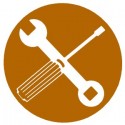Women in the Trades: A Must-Have Conversation

The trades are hard work. From the strenuous physicality to the intricacies of wiring and plumbing, these jobs are no easy task. There is a healthy demand to get these deeds done, as opportunities in the different fields abound. The hours offer flexible schedules and the pay can be quite promising. Nevertheless, there is a large portion of the population not commonly associated with careers in the trades. Progress has been made, but there is still a drastic shortage of women pursuing work and succeeding in the industry.
According to Statistics Canada, women made up five percent of all those in the trades in 2012. In comparison, hairstylists and aestheticians were predominately female at 84%. A mere five percent of women received trade qualifications in Canada in 2007. Even more alarming than those numbers is the fact that this is a decrease of 17% from fifteen years prior. There are many theories as to why the numbers are not only so small, but in some cases have apparently shrunk over time. A research report conducted in New South Wales of Australia in late 2015, entitled ‘Ducks on the Pond’, offered two troubling but fixable reasons as to why.
Practically, women on worksites may face a shortage of toilets and uniforms more typically designed for a man’s body. Beyond the aesthetic issue, wearing gloves or safety glasses that are too loose pose significant safety concerns. When women do make their way into the world of the trades, they are often met with bullying and sexual harassment. Every single woman who participated in the research for ‘Ducks on the Pond’ reported experiencing some form of discrimination or sexual harassment. One quarter of female apprentices felt they were not treated with respect by their boss. Despite these issues, many believe change is inevitable and already underway.
In Britain, 75% or more of plumbing businesses have had problems recruiting new workers. 60 million pounds was earmarked in 2003 to be devoted to persuading young people to consider the trades as a career path. The Canadian Coalition of Women in Engineering, Science, Trades and Technology (CCWEST) is encouraging women to join professional associations to help them in networking for career success. They are further encouraged to seek out a mentor, as well as scholarships, bursaries, and awards. Tina Kelly, Co-chair of CCWEST, has noted that three or four years of apprenticeship are typically required to gain proficiency in a trade skill. Women may face discrimination when they first embark on that journey, but it is a path with a very achievable goal. Tina Kelly has also stated that companies that have decided to hire female workers always find it to be a positive experience, as the decision tends to make the workforce more active and creative overall.
Awareness and visibility of women in these careers is vital. As schools provide more opportunities for technical classes, and additional education is offered to teachers and parents, previous stereotypes will slowly erode and pave way to new prospects. With technology changing the way we all work and automation set to revolutionize the workforce, many jobs in the trades will be available for women to pursue. The more we openly talk about the issue, the more inevitable that change becomes.
Sources:
Moorhead, Joanna. “Taking the man out of manual.” The Guardian. https://www.theguardian.com/world/2003/jan/17/gender.uk
Stephens, Clare and Jessie. “The two critical reasons why women don’t enter trades.” MammaMia. http://www.mamamia.com.au/women-in-trades/





Leave a comment!